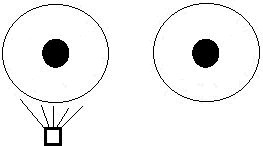

The technique here needs to be modified a little. Anisocoria:īeware of anisocoria as it can elicit a false positive RAPD. This technique can even be used in hazy corneas where visualizing the pupil may be difficult for the examiner. If the weakly lit pupil responds to the torch light being shone at the dilated pupil, then one can safely rule out RAPD in the dilated pupil. The light is swung as usual but only the normal pupil must be observed for consensual reflex while light shines on the dilated pupil. In this technique the assumed normal/ better pupil is illuminated with a weak light temporally taking care that no response occurs. RAPD testing requires just one working pupil, hence RAPD can still be checked and is often useful in making important clinical decisions. Reverse RAPD:ĭo not make the mistake of missing an RAPD in a patient with monocularly fixed dilated pupil. Place an occluder or ask the patient to place their palm on the bridge of the nose disallowing passage of any light across to the other sideĭo not forget to place an occluder on the bridge of the nose while assessing RAPD, especially in children, who have a relatively flatter nasal bridge.

The test must be performed with a halogen transilluminator/ indirect ophthalmoscope/ bright torch light.įig 6. It is important to note all these since anisocoria and small sized pupils may make it difficult to detect relative afferent pupillary defect.Īfter completing this basic examination, one must proceed to perform the swinging flash light test, keeping in mind the following ten avoidable mistakes: 1. Swinging flashlight test of Levitan:īefore performing the test, one must examine the pupil for shape, size of the pupils, anisocoria if any and reaction to light. Although the test requires both eyes, it is essential to note that it requires only one working pupil. It has been noted though, even in lesions of optic tract and pretectal afferent fibres of dorsal mid brain. It is seen in unilateral or asymmetric bilateral lesions of the retina and optic nerve upto but not involving the chiasm. A relative afferent pupillary defect (RAPD) is an important sign that detects a lesion in the afferent pathway of light reflex.


 0 kommentar(er)
0 kommentar(er)
